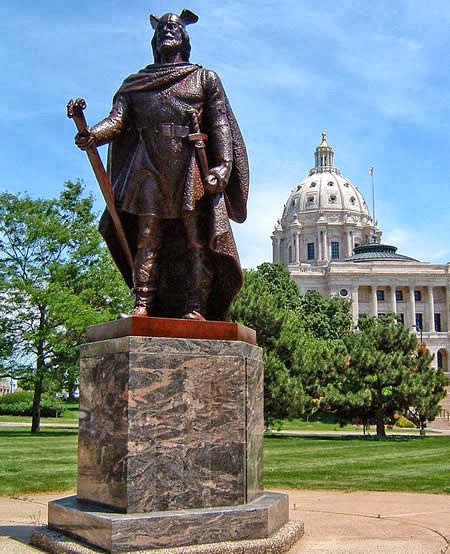 |
| Leif Ericson statue |
Leif Ericson was an Icelandic explorer who is believed to have been the first European to discover North America and, more specifically, the region that would become known as Newfoundland and then Canada. It is believed that Ericson was born around 980 to Erik the Red, a Norwegian outlaw and explorer who founded two Norse colonies in Greenland. During a stay in Norway in 999, Leif converted to Christianity, as did many other Norse around that time. He also traveled to Norway to serve King Olaf I (Tryggvason).
When he returned to Greenland, he purchased the boat of Bjarni Herjólfsson and set out to explore the land that Bjarni had sighted, which later became known as North America. In 986 Bjarni was driven off course by a fierce storm between Iceland and Greenland and sighted hilly, heavily forested land far to the west but never set foot on it.
One of the sagas, “The Saga of the Greenlanders,” states that Leif embarked around the year 1000 to follow Bjarni’s route in reverse. Leif was motivated by a sense of adventure and a desire to find more land to farm. The expedition made three landfalls.
  |
The first land they met was covered with flat rock slabs and was probably present day Baffin Island. Leif called it Helluland, which means “land of the flat stones” in Old Norse. Next he sailed to a land that was flat and wooded, with white sandy beaches, which he called Markland, meaning “woodland” in Old Norse. Markland is commonly assumed to have been Labrador.
Continuing south Leif and his men discovered land again, disembarked, and built some houses. They found the land pleasant. Salmon were plentiful in the rivers, the climate was mild, and the land was lush and green for much of the year. Leif’s 35-member party remained at this site over the winter. The sagas mention that one of Leif’s men, Tyrkir, a German warrior, found grapes.
 |
| Leif Ericson landing in America |
As a result, Leif named the country Vinland, meaning “land where the grapes grow” in Old Norse. Historians disagree on the exact location of Vinland. However, several sites along the eastern coast of the United States and Canada, from Newfoundland to Virginia, have been suggested. Many believe that the Norse settlement at L’Anse aux Meadows in Newfoundland was Leif’s colony.
Others argue that Vinland must have been more southerly, since grapes do not grow as far north as Newfoundland; however, grapes may have grown there during the Medieval Warm Period. On the return voyage to Greenland, Leif rescued an Icelandic castaway and his crew. This deed earned him the nickname “Leif the Lucky” and made him rich from his share of the rescued cargo.
Another saga, “The Saga of Erik the Red,” asserts that Leif discovered the American mainland purely by accident. According to this saga, Leif was blown off course while returning from Norway to Greenland around 1000 and landed on the shores of North America. However the saga does not mention any attempt to settle there. “The Saga of the Greenlanders” is generally considered to be the more reliable of the two.
   |
Leif’s father, Erik the Red, died shortly after his return home. As a result Leif stayed in Greenland to govern his father’s settlements. He died in 1025. All historical sources agree that Leif never returned to North America and his brother, Thorvald, led the next voyage to the new territory.
Subsequent attempts to settle Vinland were unsuccessful because of friction between the Norse settlers and the native North Americans. Nevertheless Leif stands as one of history’s greatest explorers, besting Christopher Columbus’s discovery of the New World by almost five centuries.